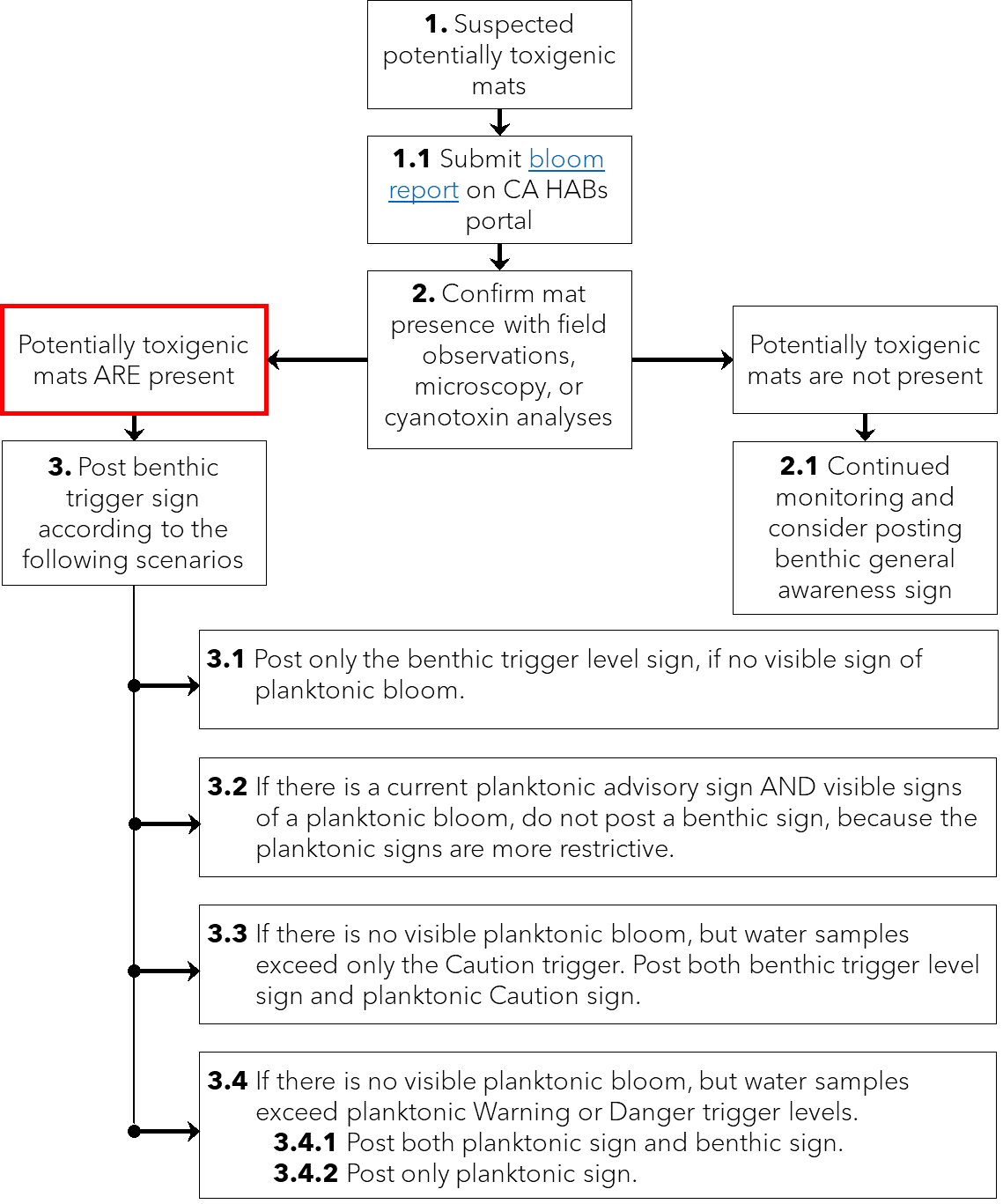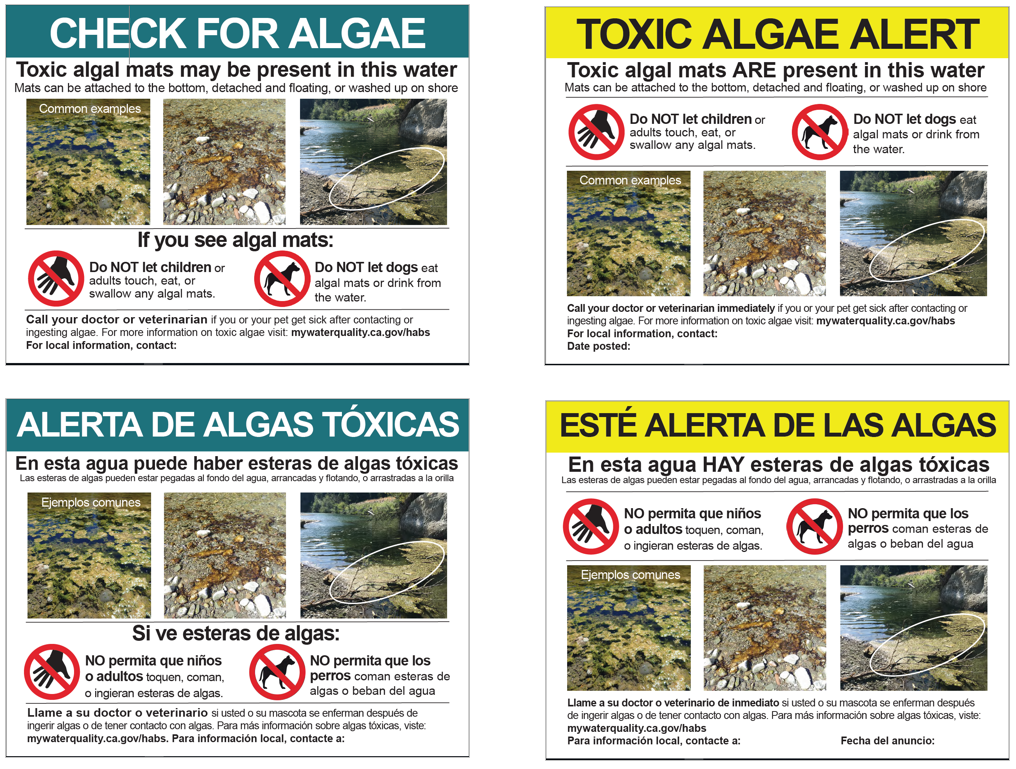Benthic Mats (Toxic Algal Mats) Signs and Posting Guidelines
While harmful algal blooms (HABs) are caused by algae or cyanobacteria that grow suspended in the water column (planktonic), some algae grow attached to the bottom (benthic zone) of water bodies and can form algal mats. Some species can produce toxins, and if present, can pose a risk to humans and pets.
For more information on toxic algal mats visit the Toxic Algal Mat FAQs web page.
When potentially toxigenic mats are observed and/or cyanotoxins are suspected or confirmed to be produced in benthic algal mats rather than by a planktonic HAB, then benthic HABs signs should posted at a location. Benthic mat signs are designed to complement the planktonic signs and posting guidance. The guidelines for placing benthic signs are described below. A full description of the benthic algal mat signs and advisories can be found here, and a PDF of this webpage can be downloaded here.
For questions about the use of the benthic mat signs or to get assistance in coordinating posting signs, email cyanoHAB.reports@waterboards.ca.gov or call 1-844-729-6466.
Advisories

- Avoid areas with algal mats, either attached, floating, or stranded on the shore.
- Do not ingest any algal mat material or swallow water that contains algal mat material.
- Do not let children play with or handle mat material.
- Do not let dogs in water with algal mat material or near stranded mats.
- Rinse off any material on a dog’s fur with clean water and ensure they do not lick off any algal mat material.
- Practice healthy water habits.
General awareness sign
- 1. Posting general awareness sign
- 1.1 If you suspect that potentially toxigenic benthic mats are likely to occur at a waterbody, then the general awareness sign can be posted prior to any visual confirmation of mats being present.
- 1.1.1 Waterbody managers can decide if they would like to post a general awareness sign.
- 1.1.2. The general awareness sign does not need any authorization from the Water Boards or County Health staff.
- 1.2 Signs can be posted seasonally or remain in place all year.
- 1.3 If a general awareness sign is posted, and a planktonic bloom occurs, then the CCHAB advisory can replace the benthic general awareness sign or be posted concurrently with the benthic general awareness sign.
- 1.1 If you suspect that potentially toxigenic benthic mats are likely to occur at a waterbody, then the general awareness sign can be posted prior to any visual confirmation of mats being present.
Trigger level sign
The posting guidelines for the benthic trigger level sign follow a similar general framework as the planktonic advisories but are not associated with the planktonic cyanotoxin trigger levels. Regional or State Water Boards staff recommend HAB advisories based on the voluntary California guidelines to the local public and/or environmental health staff, water managers, and recreation managers. The local Health staff have the jurisdiction to issue public health advisories. A water manager or recreation manager is strongly recommended to coordinate posting with the local health agency and to contact the Water Boards to get assistance in coordinating the signage posting: cyanoHAB.reports@waterboards.ca.gov or 1-844-729-6466.
The flow-chart below summarizes the process for posting a benthic trigger level sign. A detailed description of the process follows the flow-chart.
Benthic trigger level sign posting process summary

Benthic trigger level sign posting detailed process
- 1.Suspected potentially toxigenic benthic mats are present
- 1.1 File a Bloom Report by either:
- 1.1.1 Filling out the online bloom report form,
- 1.1.2. Emailing cyanoHAB.reports@waterboards.ca.gov
- 1.1.3. Calling 800-222-1222 (toll free).
- 1.2. Take photographs of the potentially toxigenic benthic mats and submit to cyanoHAB.reports@waterboards.ca.gov with Bloom Report ID number.
- 1.2.1. The online form will not support the uploading of photographs. After you submit the form, please send photographs of mats (attached, floating, or stranded) and any additional information.
- 1.3. Once the report is submitted, staff from the Regional Water Quality Control Boards or State Water Board will contact you to collect more information and coordinate additional sampling.
- 1.1 File a Bloom Report by either:
- 2. Visual confirmation or collection of mat samples
- 2.1. If potentially toxigenic benthic mats are not present, consider posting the general awareness sign and continue monitoring the site as needed.
- 2.2. If the presence of potentially toxigenic benthic mats can be confirmed based on field photographs, then the trigger level sign may be placed.
- 2.2.1 If the photographs are not clear to trained staff, then an additional site visit will be needed to obtain more information about the composition of mats and their potential for toxin production. Collection of samples for microscopy would be recommended in mixed assemblages where the presence of toxigenic species is difficult to visually determine in the field.
- 2.3. If cyanotoxins or cyanotoxin synthesis genes (via qPCR) are detected in the mat material, then the trigger level sign should be posted at the site.
- 2.3.1. Note, mat samples for cyanotoxin or gene analyses are not required to post the trigger level sign but could be collected to gather additional information.
- 2.3.2. The SWAMP field guide includes an SOP for collecting mat material.
- 3. Posting trigger level sign
Posting of trigger level signs should be coordinated with Water Boards staff, County Health staff, and waterbody managers. County Public or Environmental Health grants the authority to post a health advisory sign. All postings should be connected to a bloom report (see section 2.2). As with the CCHAB planktonic signs, the spatial extent covered by each advisory and posting is subject to the discretion of the waterbody manager, Water Boards staff, and County Health staff.- 3.1. The trigger level sign could be placed next to a planktonic general awareness sign. It is up to the discretion of the waterbody manager on how to display general awareness and trigger level signs in order to best communicate risk to the public.
- 3.2. If there is visual evidence of a planktonic bloom and water concentrations exceed the planktonic Caution, Warning, or Danger trigger levels, even if benthic mats are also present, the appropriate planktonic advisory sign should be posted. Posting only the benthic trigger level sign is not recommended, since this trigger sign is less restrictive and contains fewer advisories than the CCHAB planktonic signs.
- 3.3. If potentially toxigenic mats are present and there are no visual indicators of a planktonic bloom, but cyanotoxins are detected in the water column at levels above the Caution planktonic trigger, yet below Danger or Warning triggers, then triggers for both the benthic trigger level sign and the planktonic Caution advisory have been met, though it is likely that the source of the water column anatoxin-a is the benthic mats.
- 3.3.1. The benthic trigger level sign and the planktonic Caution sign should be placed at the water body
- 3.3.2. The planktonic Caution sign should not be posted alone because it does not adequately communicate the risk of mats to the public.
- 3.3.3. Note, it is not required to collect water column samples when there are no signs of a planktonic bloom and cyanotoxins are thought to be produced in mats.
- 3.4. In the rare circumstance that toxic benthic mats are confirmed and water column concentrations reach the CCHAB Warning or Danger level without any visual evidence of a planktonic bloom, we recommend coordination between the responding waterbody managers, Regional/Water Boards staff, and local Public Health staff to determine which of the following two signage options is most appropriate to protect public health for the given situation.. The two signage options are:
- 3.4.1. Post both the benthic trigger level and the appropriate CCHAB planktonic sign (Warning or Danger).
- 3.4.2. Only post the CCHAB planktonic sign.
- 4. Continued monitoring and de-posting
- 4.1 Once the trigger level sign is posted, then the site should be monitored for presence of benthic mats (attached, floating and detached, or stranded onshore).
- 4.2. Trigger level signs can be removed, if visual surveys do not identify potentially toxigenic benthic mats or mat samples have no cyanotoxin or cyanotoxin synthesis gene detections over a 2-week period (consistent with the current CCHAB de-posting criteria).
- 4.2.1. Local health officials should be notified of the changing advisory status when trigger level signs are removed, and the advisory status should be changed on the CA HABs Portal incident map by coordinating with the Regional or Water Boards staff.
Downloading signs
Signs are available as 8.5x11 inch PDFs in English or Spanish. Click the signs below to download files. For questions about the use of the benthic mat signs or to get assistance in coordinating posting signs, email cyanoHAB.reports@waterboards.ca.gov or call 1-844-729-6466.


